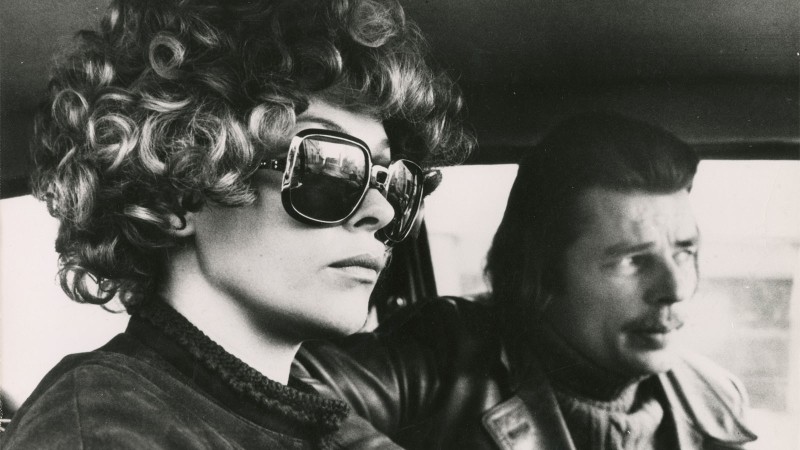Vital Revivals

The Revivals lineup announced on Thursday for this year’s New York Film Festival includes new restorations of Robert Bresson’s Four Nights of a Dreamer (1971), Frederick Wiseman’s Model (1981), Lino Brocka’s Bona (1980), and Zeinabu irene Davis’s Compensation (1999), which Kevin Thomas hailed in the Los Angeles Times as “an important achievement, illuminating and captivating.” Meantime, much of this week has been spent reflecting on the lives and work of Gena Rowlands, who died on August 14, and Alain Delon, who passed away just four days later.
- Introducing its current series Paramount in the 1970s, MoMA reminds us that it was the “massive success” of Francis Ford Coppola’s The Godfather (1972) that allowed the studio to become “a gateway for some of the most mature, risk-taking films” of that decade. The film and its sequel, The Godfather: Part II (1974), will screen not only at MoMA but also at the Belcourt in Nashville as part of its Essential Coppola series. For the Atlantic, Mark Asch revisits the film Coppola slipped in between the two parts of his mafia epic. “Though recent appreciations of The Conversation [1974] have aptly drawn parallels between the film and our semi-voluntary participation in the digital panopticon half a century on,” writes Asch, “Coppola’s film is more precisely a reflection of how surveillance shapes the power imbalances that define the world of work.”
- When Coppola saw Not a Pretty Picture (1975), he signed its young director, Martha Coolidge, to a deal at American Zoetrope. “That was the real surprise,” Coolidge tells Jim Hemphill at IndieWire. “This isn’t exactly the kind of film that you would think was an open door to Hollywood.” She walked through that door, though, and made Valley Girl (1983) with Nicolas Cage, Real Genius (1985) with Val Kilmer, and Rambling Rose (1991) with Laura Dern. Not a Pretty Picture blends a reenactment of Coolidge’s rape in 1962 with discussions with the cast about what they’re going through. “Coolidge’s seminal film is a fascinating window onto another time,” writes Molly Haskell for our new release, “but alas, Not a Pretty Picture also seems horribly contemporary, shudder-inducing in its relevance.”
- In John M. Stahl’s Leave Her to Heaven (1945), Gene Tierney plays an eye-catching socialite whose desire to secure some time alone with her new husband leads her to commit what crime novelist Megan Abbott calls “one of the wickedest acts in movie history.” It’s playing in our Vacation Noir program on the Criterion Channel, and Sean Burns has taken another look at it for Crooked Marquee, noting that the film “looks and sounds like what were commonly referred to as ‘women’s pictures’ back in the day, yet its soul lies in the moody, psychological wreckage of the era’s most remorseless crime stories.” Burns also notes that in his 1945 review for the New York Times, Bosley Crowther “called Leave Her to Heaven ‘plainly a piece of cheap fiction done up in Technicolor and expensive sets,’ as if that isn’t what’s so awesome about it.”
- Asghar Farhadi’s first two features, Dancing in the Dust (2003) and Beautiful City (2004), are finally available in the U.S. on Blu-ray and via streaming, prompting Jonathan Kirshner’s thorough and insightful overview of the oeuvre in the Boston Review. Kirshner takes us from Farhadi’s years as a theater student at the University of Tehran through an appreciation of the Oscar-winning films A Separation (2011) and The Salesman (2016) to the present precarious moment. Farhadi has described himself as “a filmmaker who ‘places a question mark’ with his movies, for which he doesn’t have ‘definite answers,’” writes Kirshner, adding that his “searing, searching, social dramas are all the more remarkable for having been produced under one of the most draconian (and punitive) censorship regimes in the world; the writer-director has navigated a tightrope that may finally be fraying under his feet.”
- The American Cinematheque’s Jacques Rozier retrospective will run from August 31 through September 11, and writing for Film Comment, Beatrice Loayza calls Adieu Philippine (1962) “a quintessential summer movie. And like all of Rozier’s films, it’s a roving, improv-heavy hangout sesh anchored by a neorealist sensibility. It’s also deceptively frothy, as hiding beneath its vibrant holiday vibe, complemented by flamenco guitar and the frisky rapport of its central love triangle, are undercurrents of profound anxiety. The coy relationship drama, carried out by naturalistic performances, recalls the romantic intrigues of Eric Rohmer or Jean Eustache, while the film’s loose-limbed structure and jazzy flow are redolent of Jacques Rivette.” But underneath Rozier’s “comic impulses are serious existential inquiries into questions of freedom.”



